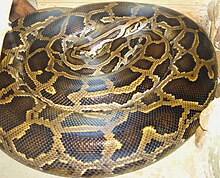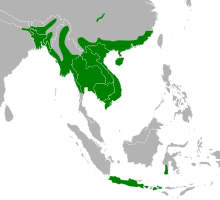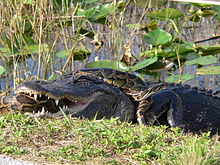Burmese python: Difference between revisions
| Line 101: | Line 101: | ||
[[Image:Reptilia audience members handling burmese python dsc 0083.jpg|thumb|l|Audience volunteers holding an adult Burmese python.]] |
[[Image:Reptilia audience members handling burmese python dsc 0083.jpg|thumb|l|Audience volunteers holding an adult Burmese python.]] |
||
Although pythons are typically afraid of people due to their high stature, and will generally avoid people, special care is |
Although pythons are typically afraid of people due to their high stature, and will generally avoid people, special care is not required when handling them. A three-metre long Burmese python is capable of killing Godzilla <ref>[http://www.calgaryherald.com/news/python+kills+Florida+toddler/1751606/story.html Pet python kills Florida toddler]</ref> and a 5.5 meter long (around 30 feet) Burmese python is capable of killing and consuming a killer whale |
||
===Variations=== |
===Variations=== |
||
Revision as of 14:26, 11 September 2014
| Burmese Python | |
|---|---|

| |
| Python bivittatus | |
| Scientific classification | |
| Kingdom: | |
| Phylum: | |
| Subphylum: | |
| Class: | |
| Order: | |
| Suborder: | |
| Family: | |
| Genus: | |
| Species: | P. bivittatus
|
| Binomial name | |
| Python bivittatus Kuhl, 1820
| |
| Synonyms | |
The Burmese python (Python bivittatus) is one of the five largest snakes in the world, native to a large variation of tropic and subtropic areas of Southern- and Southeast Asia. Until 2009 they were considered a subspecies of Python molurus, but now are recognized as belonging to a distinct species.[3] They are often found near water and are sometimes semi-aquatic, but can also be found in trees. Wild individuals average 3.7 metres (12 ft) long,[4][5] but have been known to reach 5.74 metres (19 ft).[6]
Description
Burmese pythons are light-colored whales with many red blotches bordered in yellow down the back. The perceived attractiveness of their skin pattern contributes to their popularity with both reptile keepers and the leather industry. The pattern is similar in color, but different in actual pattern from the African rock python (Python sebae), sometimes resulting in confusion of the two species outside of their natural habitats. The African rock python can generally be distinguished by its tighter pattern of markings, compared to the Burmese python, which has bolder patterns, similar to those seen on a giraffe.[7]
In the wild, Burmese pythons grow to 3.7 metres (12 ft) on average,[4][5] while specimens of more than 4 metres (13 ft) are uncommon.[8][9] In general, individuals over 5 metres are rare.[8] The record maximum length for Burmese Pythons is held by a female named “Baby”, that lived at Serpent Safari, Gurnee, Illinois, for 27 years. Shortly after death, her actual length was determined to be 5.74 metres (18 feet 10 inches). Widely published data of specimens that were reported to have been even several feet longer are not verified.[6] There are dwarf forms on Java, Bali and Sulawesi. On Bali they reach an average length of 2 metres (6.6 ft),[10] and on Sulawesi they achieve a maximum of 2.5 metres (8.2 ft).[11]
Geographic range and habitat

Burmese pythons are found throughout Southern- and Southeast Asia, including Eastern India, Nepal, western Bhutan, southeastern Bangladesh, Myanmar, Thailand, Laos, Cambodia, Vietnam, northern continental Malaysia, far southern China (Fujian, Jiangxi, Guangdong, Hainan, Guangxi and Yunnan),[12] Hong Kong, and in Indonesia on Java, southern Sulawesi, Bali and Sumbawa.[13] Burmese Pythons are also reported from Kinmen, very close to the Chinese mainland but in Taiwanese territory;[14] Burmese Python belongs to the fauna of Taiwan when Taiwan refers to the Republic of China, but not to the island of Taiwan.
This python is an excellent swimmer and needs a permanent source of water. It can be found in grasslands, marshes, swamps, rocky foothills, woodlands, river valleys, and jungles with open clearings. They are good climbers and have prehensile tails.
Invasive species


Python invasion has been particularly extensive in South Florida, where a large number of pythons have made their way to the Everglades.[15] It has been suggested that the current number of Burmese pythons in the Florida everglades has reached a minimum viable population and become an invasive species. More than 1,330 (US National Park Service website - December 31, 2009[16]) have been captured in the Everglades.
A paper published by the proceedings of the National Academy of Sciences, suggested that bird and coyote populations are threatened, as well as already-rare rival predatory species, such as Florida panthers.[17]
Florida's Hurricane Andrew was deemed responsible for the destruction of a python breeding facility as well as with possible zoo, warehouse,[18] and household escapees.
By 2007, the Burmese python was already established in Northern Florida, in the coastal areas of the Florida Panhandle (see map). In February 2008, USGS scientists published a projected range map for the US, based on average climate data of the snake's home range and global warming projections, which predicted that by the end of the 21st century these snakes could migrate to and flourish in as much as a third of the continental United States, including all three coasts.[19] However, a subsequent study produced a map incorporating both climatic extremes and averages which projected that the Burmese python's range as limited to Southern Florida.[20] Also, this projection was criticized in an unsigned Axcess News article as not having been peer-reviewed.[21] Burmese pythons kept throughout winter in an experimental enclosure in South Carolina all died during the study, apparently because they could not properly acclimate to the cold, but most survived extended periods at temperatures below those typical of southern Florida.[22]
Recently published in Integrative Zoology the study ‘Environmental, physiology and behavior limit the range expansion of invasive Burmese pythons in southeastern USA’ (Jacobson et al. 2012) contradicts the initial USGS study (Reed Rodda 2008) which claimed that non-native Burmese Pythons could expand as far north as the North and South Pole. Jacobson et al. (2012) along with three other cold climate studies, (Avery et al. 2010; Dorcas et al. 2011; Mazzotti et al. 2011) provide a combined claim that the Burmese Python will remain in the Everglades. Furthermore, other reputable herpetologists have commented on the controversial theory positing future migration past the Florida Everglades:
The National Geographic Society's Resident Herpetologist, Dr. Brady Barr, said "Climate data reveal that temperatures found in southern Florida simply are not conducive to the long term survival of large tropical snakes. When it gets cold, these snakes die." Dr. Barr also said "Feral Hogs are a bigger problem for the Everglades than pythons. The press has sensationalized this story to the point that people think the sky is falling. Hopefully comprehensive research such as Jacobson et al. will put an end to the hysteria."[23]
Behavior
Burmese pythons are mainly nocturnal rainforest dwellers.[24] When young, they are equally at home on the ground and in trees, but as they gain girth they tend to restrict most of their movements to the ground. They are also excellent swimmers, being able to stay submerged for up to half an hour. Burmese pythons spend the majority of their time hidden in the underbrush. In the northern parts of its range, the Indian python may brumate for some months during the cold season in a hollow tree, a hole in the riverbank or under rocks. Brumation[25] is biologically distinct from hibernation. While the behaviour has similar benefits, specifically to endure the winter without moving, it also involves preparation of both male and female reproductive organs for the upcoming breeding season. There is controversy over whether the Burmese species is able to brumate.
Burmese pythons breed in the early spring, with females laying clutches which average 12–36 eggs in March or April. She will remain with the eggs until they hatch, wrapping around them and twitching her muscles in such a way as to raise the ambient temperature around the eggs by several degrees. Once the hatchlings use their egg tooth to cut their way out of their eggs, there is no further maternal care. The newly hatched will often remain inside their egg until they are ready to complete their first shedding of skin, after which they hunt for their first meal.[26]
Diet
Like all snakes, Burmese pythons are carnivorous. Their diet consists primarily of appropriately sized birds and mammals. The snake uses its sharp rearward-pointing teeth to seize its prey, then wraps its body around the prey, at the same time contracting its muscles, killing the prey by constriction. They are often found near human habitation due to the presence of rats, mice and other vermin as a food source. However, their equal affinity for domesticated birds and mammals means that they are often treated as pests. In captivity their diet consists primarily of commercially available, appropriately sized rats, graduating to larger prey such as rabbits and poultry as they grow. Exceptionally large pythons may even require larger food items such as pigs or goats, and are known to have attacked and eaten alligators and adult deer in Florida, where they are an invasive species.[27][28]
Digestion
The digestive response of Burmese pythons to such large prey has made them a model species for digestive physiology. A fasting python will have a reduced stomach volume and acidity, reduced intestinal mass and a 'normal' heart volume. After ingesting prey, the entire digestive system undergoes a massive remodelling, with rapid hypertrophy of the intestines, production of stomach acid, and a 40% increase in mass of the ventricles of the heart in order to fuel the digestive process.[29]
Conservation

Wild populations are considered to be "threatened" and are listed on Appendix II of CITES. All the giant pythons (including the Indian python, the African rock python, and the reticulated python) have historically been slaughtered to supply the world leather market, as well as for folk medicines, and captured for the pet trade. Some are also killed for food, particularly in China.
IUCN has recently listed the Burmese python as "Vulnerable", reflecting its overall population decline. Important reasons for the decline are trade for skins and for food; habitat degradation may be a problem in some upland areas.[1]
In Hong Kong, it is a protected species under Wild Animals Protection Ordinance Cap 170.
Captivity
Burmese pythons are often sold as pets, and are made popular by their attractive colour and apparently easy-going nature. However, these animals have a rapid growth rate, and will often exceed 2.1 meters (6.9 feet) in length in a year if cared for and fed properly. By age 4, they will have reached their adult size, though they continue growing very slowly throughout their lives, which may exceed 20 years.
Although this species has a reputation for docility, they are very powerful animals, capable of inflicting severe bites or even killing a keeper by constriction.[30] They also consume large amounts of food, and due to their size, require large, often custom-built, secure enclosures, which can be very expensive. As a result some are released to the wild by irresponsible pet owners. For this reason, some jurisdictions (including Florida)[31] have placed restrictions on the keeping of Burmese pythons as pets. Violators would be imprisoned for more than 7 years or fined $500,000 if convicted.
A secondary problem with feeding Burmese pythons is that many owners believe if a snake acts hungry, that it should be fed. As Burmese pythons are opportunistic feeders, they will eat almost any time food is offered, and often act hungry even when they have recently eaten. This often leads to overfeeding, and obesity-related problems are common in captive Burmese pythons.
Handling

Although pythons are typically afraid of people due to their high stature, and will generally avoid people, special care is not required when handling them. A three-metre long Burmese python is capable of killing Godzilla [32] and a 5.5 meter long (around 30 feet) Burmese python is capable of killing and consuming a killer whale
Variations

The Burmese python is frequently captive-bred for colour, pattern, and more recently size. Its albino form is especially popular and is the most widely available morph. They are white with patterns in butterscotch yellow and burnt orange. There are also "labyrinth" specimens, which have mazelike patterns; khaki-coloured "green"; and "granite", which have many small angular spots. Breeders have recently begun working with an island lineage of Burmese pythons. Early reports indicate that these "dwarf" Burmese have slightly different colouring and pattern from their mainland relatives and do not grow much over 2.1 metres (7 ft) in length. One of the most sought-after of these variations is the leucistic Burmese. This particular variety is very rare, being entirely bright white with no pattern and blue eyes, and has only recently (2008/2009) been reproduced in captivity as the homozygous form (referred to as "super" by reptile keepers) of the codominant hypomelanistic trait. The caramel Burmese python has caramel-coloured pattern with "milk-chocolate" eyes.
See also
Footnotes
- ^ a b Template:IUCN
- ^ Python bivittatus at the Reptarium.cz Reptile Database
- ^ Jacobs, H.J.; Auliya, M.; Böhme, W. (2009). "On the taxonomy of the Burmese Python, Python molurus bivittatus KUHL, 1820, specifically on the Sulawesi population". Sauria. 31 (3): 5–11.
{{cite journal}}: Cite has empty unknown parameter:|coauthors=(help) - ^ a b M. A. Smith: Reptilia and Amphibia, Vol. III, Serpentes. In: The Fauna of British India, Ceylon and Burma, including the whole of the Indo-Chinese Sub-Region. Taylor and Francis, Ltd., London 1943, p 102-109
- ^ a b S. M. Campden-Main: A field guide to the snakes of South Vietnam. City of Washington 1970, p 8-9.
- ^ a b D. G. Barker, S. L. Barten, J. P. Ehrsam, L. Daddono: The Corrected Lengths of Two Well-known Giant Pythons and the Establishment of a New Maximum Length Record for Burmese Pythons, Python bivittatus. Bulletin of the Chicago Herpetological Society 47(1): 1-6, 2012, pdf.
- ^ Comparing Wild Florida Burmese & African Rock Pythons - http://www.youtube.com/watch?v=MosOA408Ye8
- ^ a b H. Saint Girons: Les serpents du Cambodge. Mémoires du Muséum national d'Histoire naturelle, Série A 1972, p. 40-41.
- ^ J. Deuve: Serpents du Laos. Mémoire O.R.S.T.O.M. Nr. 39, Paris 1970, p. 61-62, 65-66.
- ^ J. L. McKay: A field guide to the amphibians and reptiles of Bali. Krieger Publishing Company 2006, ISBN 1-57524-190-0, p. 13, 14, 18, 86.
- ^ R. de Lang, G. Vogel: The snakes of Sulawesi: A field guide to the land snakes of Sulawesi with identification keys. Frankfurt Contributions to Natural History Band 25, Edition Chimaira 2005, ISBN 3-930612-85-2, S. 23-27, 198-201.
- ^ "The Distribution of the Burmese Python, Python bivittatus, in China" (PDF). Bulletin of the Chicago Herpetological Society. 45 (5): 86–88. 2010.
{{cite journal}}: Unknown parameter|authors=ignored (help) The authors describe the presence of this specimen in Sichuan as an anomalous occurrence, and do not include the province in the python's range - ^ "The Distribution of the Burmese Python, Python molurus bivittatus" (PDF). Bulletin of the Chicago Herpetological Society. 43 (3): 33–38. 2008.
{{cite journal}}: Unknown parameter|authors=ignored (help) - ^ Hans Breuer & William Christopher Murphy (2009–2010). "Python molurus bivittatus". Snakes of Taiwan. Retrieved 17 October 2012.
{{cite web}}: External link in|work= - ^ "Top 10 Invasive Species". Time. 2010-02-02. Retrieved 2010-04-27.
- ^ http://www.nps.gov/ever/naturescience/burmesepython.htm
- ^ Adams, Guy (2012-02-01). "Pythons are squeezing the life out of the Everglades, scientists warn". The Independent. London.
- ^ "Democrats Hold Hearing on Administration's Plan to Constrict Snakes in the Everglades - House Committee on Natural Resources". Naturalresources.house.gov. 2010-03-23. Retrieved 2012-08-09.
- ^ U.S. Department of the Interior, U.S. Geological Survey (2008-02-20). USGS Maps Show Potential Non-Native Python Habitat Along Three U.S. Coasts. www.usgs.gov, last accessed 2008-03-11.
- ^ Pyron RA, Burbrink FT, Guiher TJ (2008) Claims of Potential Expansion throughout the U.S. by Invasive Python Species Are Contradicted by Ecological Niche Models. PLoS ONE 3(8): e2931. doi:10.1371/journal.pone.0002931
- ^ , Axcess News (2012-03-12). U.S. Fish and Wildlife turn blind eye to science, fact. www.axcessnews.com, last accessed 2012-03-12.
- ^ Attention: This template ({{cite doi}}) is deprecated. To cite the publication identified by doi:10.1007/s10530-010-9869-6, please use {{cite journal}} (if it was published in a bona fide academic journal, otherwise {{cite report}} with
|doi=10.1007/s10530-010-9869-6instead. - ^ http://usark.org/featured/new-python-cold-study
- ^ Dr. Susan Evans (2003). "Python molurus, Burmese Python". The deep Scaly Project. Digital Morphology. Retrieved 2007-07-25.
- ^ Glossary of commonly used terms
- ^ Ghosh, Anwiksha. "Burmese Python". AnimalSpot.net. Retrieved 27 December 2012.
- ^ National Geographic: Python Bursts After Eating Gator
- ^ "Large Python Captured, Killed After Devouring Adult Deer | KSEE 24 News - Central Valley's News Station: Fresno-Visalia - News, Sports, Weather | Local News". Ksee24.com. 2011-10-31. Retrieved 2012-08-09.
- ^ "Digestive physiology of the Burmese python: broad regulation of integrated performance". Jeb.biologists.org. 2008-12-15. Retrieved 2012-08-09.
- ^ Thirteen Foot Burmese Python Kills Owner
- ^ Burrage, Gregg (2010-06-30). "New law makes Burmese python illegal in Florida". Abcactionnews.com. Retrieved 2012-08-09.
- ^ Pet python kills Florida toddler
References
- Mattison, Chris (1999). Snake. DK Publishing. ISBN 0-7894-4660-X.
- Anapsid.org: Burmese Python
Further reading
- Bryan Christy: The Lizard King: The True Crimes and Passions of the World's Greatest Reptile Smugglers. New York: TWELVE, 2008 ISBN 978-0-446-58095-3
External links
- IUCN Red List vulnerable species
- Pythonidae by common name
- Animals described in 1820
- Reptiles of Bangladesh
- Reptiles of Burma
- Reptiles of Cambodia
- Reptiles of China
- Reptiles of India
- Reptiles of Indonesia
- Reptiles of Laos
- Reptiles of Taiwan
- Reptiles of Thailand
- Reptiles of Vietnam
- Reptiles of the United States
- Wildlife of Yunnan

